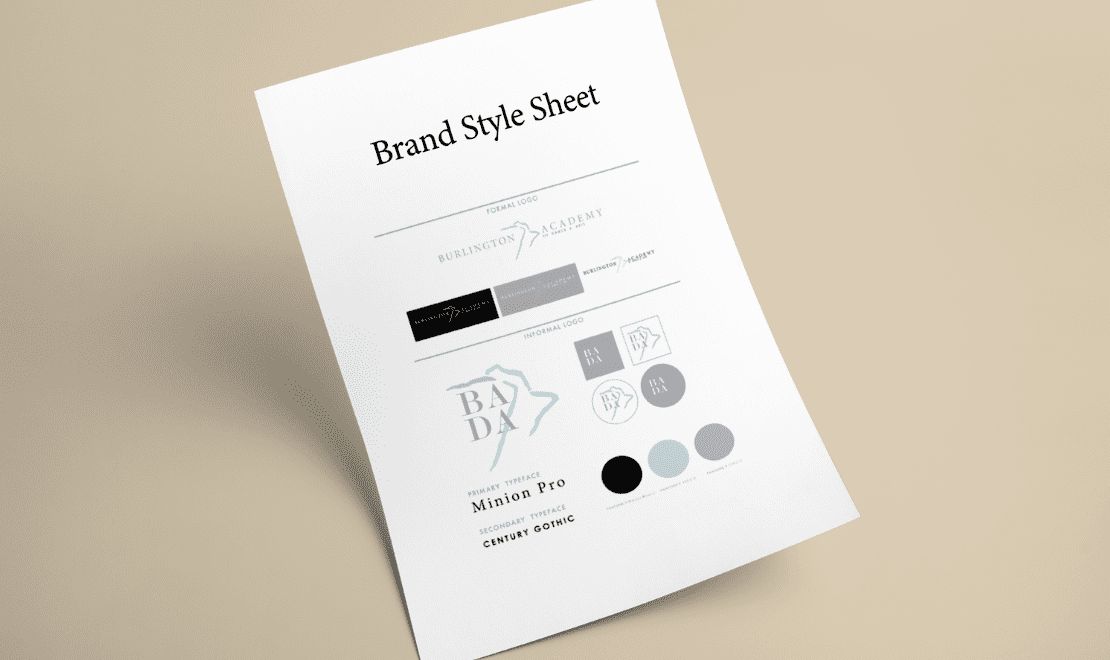If you’re a studio or gymnastics club owner, you know your branding basics. You’ve created a logo, maybe stayed consistent with colors and fonts, but do you truly know your brand inside and out? If not, it may be time to create a brand guide!

The main benefits to creating your own brand guide is to have a clear vision of your brand and your business. A brand guide is much more than establishing a logo, font, and a few colors; it’s about diving deep and establishing the messaging and meaning behind your brand. A brand guide is an internal document to be shared with staff to give everyone clear guidelines on how to represent your brand. Let’s review the essential elements of a basic branding guide.
Mission
Whether your business is six months or six years old, establishing a mission statement helps you and your customers understand the meaning behind your brand. It can help your customers connect with you and your brand and help them understand why they should choose your studio or gym. To create your mission statement, sit down and write out everything that is important to your brand, why you started, and what you want people to know and remember about your business. Once you have a clear idea of what your brand is, write a short paragraph as your mission statement. Once you’ve created your mission statement, you place it on the first page of your website, or on your “About Us” page.
Values
This next section will be much easier after completing your mission statement. Stating your values in your brand guide informs new staff members about the studio or gym they’re joining and what things are important to you and the brand.
Logo Usage
You’ve built your brand from the ground up and want everyone representing it properly. This is why clear guidelines on logo usage are so important. You may only have one logo, or you may have a badge logo, a text logo, and a logo with both. No matter how many logos you have, you and your team should all be on the same page as to how, when and where to use it/them. Having rules on what colors your logo can be shown in, which logo is appropriate for different occasions, and what documents or locations you never want your logo to be are important to ensure your branding is always consistent.
Fonts
You may have a font or two that you use on a semi-regular basis but also have a few different fonts that you like to use from time to time. Having a brand font helps establish brand identity and awareness. If you’re using the same font that’s unique to your brand, people will begin to associate that font with your business, resulting in quicker brand recognition. You can search on Google Fonts or a website such as dafont.com to find the perfect font for your business. It’s recommended to choose both a primary and secondary font as you may need different looks for different purposes. It’s best to find a serif and sans-serif font because your primary font will be used for titles and your secondary font will be used for sub-text underneath titles and other smaller text. Typically, if you’re going for a serif font, it will be your primary font and the sans-serif font will be your secondary font. Take your time selecting your fonts to ensure they give the proper message about your brand. Once you’ve selected your fonts, stick to them!
Color Palette
Most studios and clubs have a clear color palette for their main branding. However, sometimes there are marketing materials, team wear or other things where your colors may not work. If you’ve ever been in this situation, you probably altered your colors slightly to make them work for the situation. However, this is why having a standard color palette is so important for maintaining consistency in your branding. You know your main colors, however, do you have secondary colors ready?
Brand Voice
Establishing your brand voice is critical in being able to keep your messaging consistent and allow your audience to understand you as a brand. You can either work with your team to establish the tone you want your brand to have, or you can decide it on your own. Do you want your branding to be serious and professional, fun and playful, creative and bold? There are many different directions you can take with the voice of your brand; what’s important is that you stay true to the voice and tone that you decide.
Having a brand guide and fully understanding who you are as a company comes in handy when designing your team wear. Knowing all your colors, fonts, design elements and more make designing your team wear a breeze! For example, knowing your color palette allows you to play around with different combinations of your colors and allows your Teamwear Specialist to know which direction to go with for your design. Knowing your fonts makes for easy design as you can use your secondary or primary font for your students’ names on your custom garments and don’t have to spend time choosing a new font for names. By knowing your brand voice and tone, you’re able to work with your Teamwear Specialist to convey that messaging through your design.
If you’re creating a basic brand guide, these are all the elements that are necessary to establish for your brand. There are other elements that can be added if you’d like to dive into more detail, however, every brand should have a basic brand guide! This is not only useful to you as a business owner, but also to your current employees and new employees that join your team. This is a simple way to allow them to get established with your brand, any rules around your brand, and to understand how your audience sees you. Happy branding!
